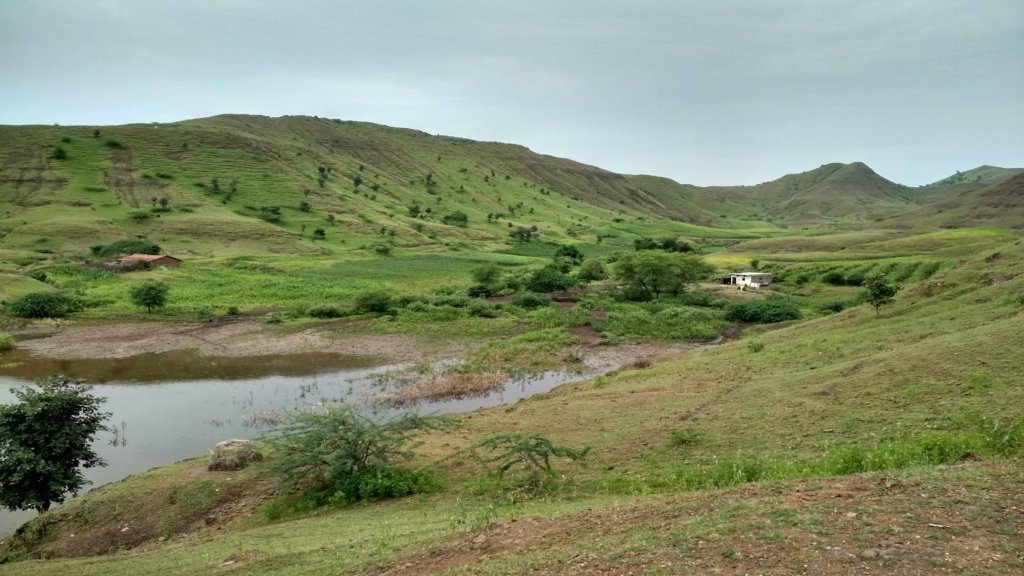Watersheds in India as emergent infrastructures
Shashank Deora
August 9, 2021 | Reflections
India is the world’s second-most populous country. More than 60% of India’s population lives in its rural areas and as per the latest government agricultural statistics close of half of it is engaged in agriculture for their livelihood in one way or the other. A study on watershed (development and management) programmes in India reports that these programmes have been a critical intervention to support agriculture through land and soil conservation. It also observes that the state and the civil society organisations in India have been promoting watershed programmes for a few decades now.

Picture of a micro-watershed from Pati block of Barwani district in the central Indian state of Madhya Pradesh
Watershed refers to a geographic area that drains to a common point, as discussed in a World Bank paper. A healthy watershed not only supports agriculture, but it also provides various ecosystem services like safe drinking water and biodiversity conservation. A 2017 review of watershed management in South Asia observes that watershed programmes promote multiple technological interventions across the watershed. These interventions are aimed at land and soil conservation to help natural resource conservation and support livelihoods. These programmes achieve greater importance with the COVID19 pandemic pushing millions of people into extreme poverty as a World Bank press release points out.
Watershed development and management is a more ecologically sensitive alternative to the large dams in supplementing irrigation in rain-fed agriculture. Designing watershed programmes also involves greater participation of local communities when compared to larger water infrastructures. In fact, the trajectory of the evolution of watershed programmes in India indicates, learning from the limitations of earlier technology and expert dominated approach, a shift to a more participatory and social organisation-centric approach. However, research shows that the success of these programmes in achieving their desired outcomes has still been limited to a few isolated cases. With this limited success, the goal to maintain healthy watersheds across the landscape remains elusive.
The limited success of watershed programmes begs the question: what is preventing them despite close to half a century of experience? This question may have several answers. Research on watershed highlights significant challenges related to the governance, institutional arrangements around watersheds. Experience of watershed programmes in India suggests that many of the governance challenges stem from inequity in the cost and benefit distribution from watershed programmes and the diverging interests of multiple stakeholders associated with a watershed. For instance, in India, the governance of different natural resources (water, forest, common pasture lands) in a watershed falls under different ministries’ jurisdiction who do not necessarily converge in terms of their governance priorities. It gets more complex and layered with the changing priorities of watershed governance as one moves away from the watershed’s geographic location to different decision-making levels.
Challenges to its governance necessitate recognising governance institutions around a watershed at par with the technological interventions in the watershed programme. At the same time, it requires a realization of the diverse local and regional contexts across India within which a one-size-fits-all approach to watershed governance and watershed programmes may not work.
A watershed programme’s design which works in the semi-arid Rajasthan in the north-western part of the country may not work in the south-western Konkan region witnessing heavy annual rainfall on steep slopes. Something that works with communities well-versed in and practicing settled cultivation for at least a century in the southern state of Tamil Nadu may not suit the remote forested regions of central India inhabited by indigenous populations who have adopted settled cultivation more recently with a different crop choice and have a different kind of dependence on agriculture. Watershed programmes in an area with more homogeneous communities may perform very differently from those in an area inhabited by very heterogeneous communities. Watershed development and management activities which are part of a government programme like MGNREGA (Mahatma Gandhi National Rural Employment Guarantee Act) may have different outcomes and even different motivations than the watershed programmes promoted by a civil society organization. Multitudes of such differentiating scenarios can be listed.
Thus, a watershed programme is affected by the elements external to its design, including the political, social, economic, and ecological contexts of its operation. Its dependence on multiple external factors makes each watershed a unique entity and a watershed programme with the same recipe can create different outcomes for different watersheds. The process through which watersheds emerge as infrastructure via a watershed programme can reveal much about the nature of outcomes.
The process through which the technological interventions are designed for a watershed and are actually implemented within its broader context plays a critical role in deciding how would the watershed be transformed. Understanding this infrastructuring process around watersheds can also partly answer the question raised earlier in this blog post about the challenges to watershed programmes. Amid growing concerns of deteriorating ecological health across the country and the recent dam accident in Uttarakhand, understanding infrastructuring around watersheds for their better development and management can be one of the many things to strive for.
Shashank is a PhD student at the Centre for Technological Alternatives for Rural Areas (CTARA), Indian Institute of Technology Bombay in Mumbai, India. This blog post talks about a part of his PhD research, where he is attempting to understand watersheds’ emergence through watershed development and management programmes and its implications for watershed governance and watershed outcome.
Published: 08/09/2021
